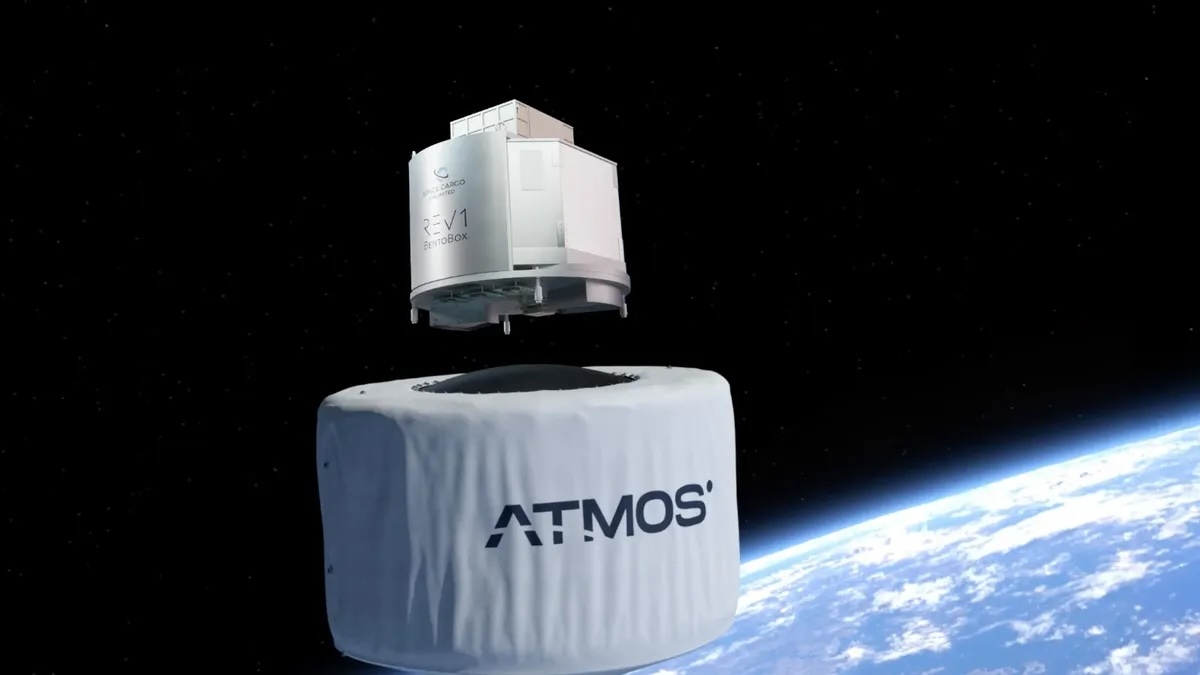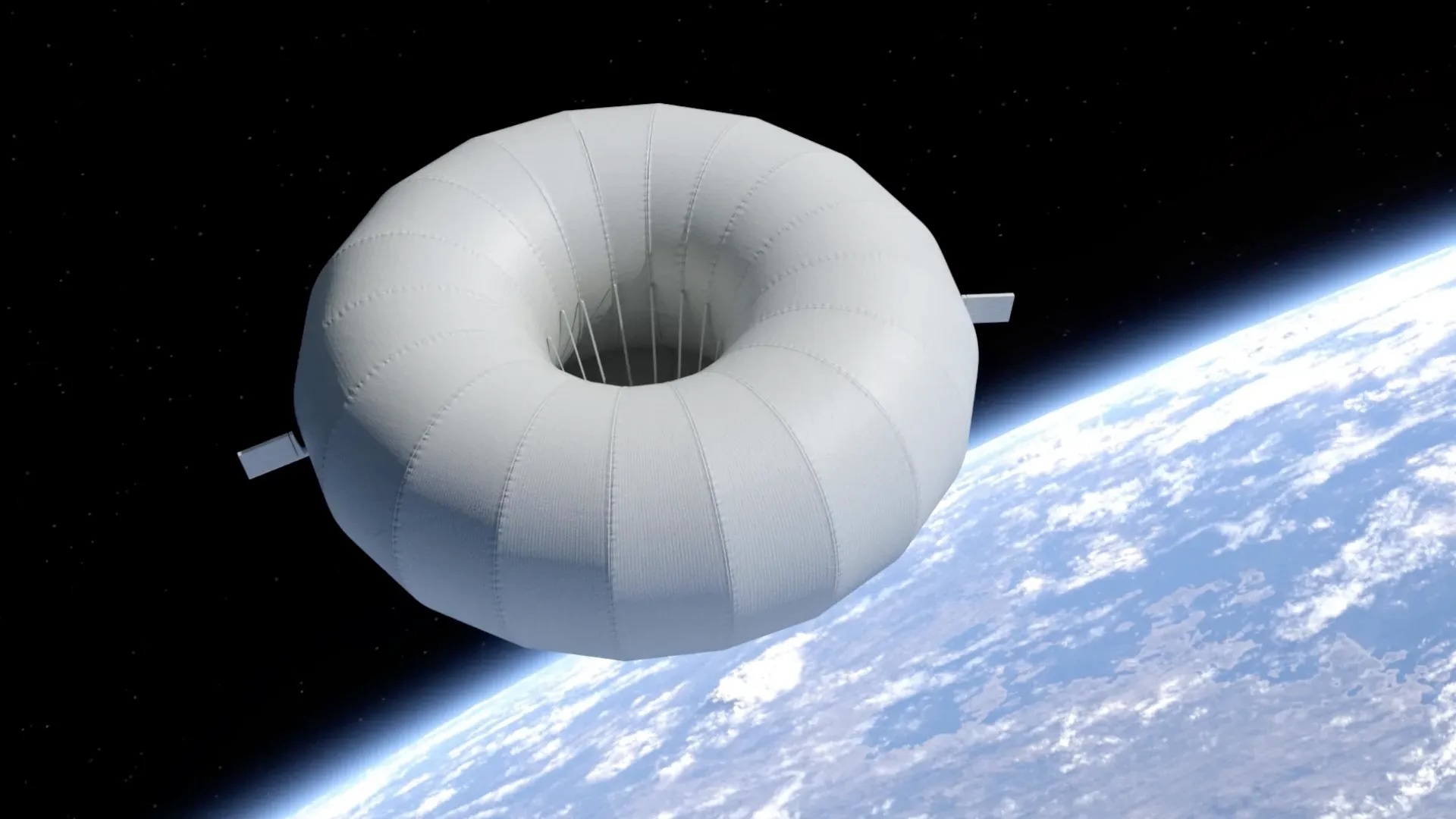7.02.2025
Atmos' first Phoenix capsule will fly on the Bandwagon 3 rideshare mission this spring.

Artist's illustration of Atmos Space Cargo's hardware in Earth orbit. (Image credit: Atmos Space Cargo)
A European company will give its cargo-return tech its first in-space test this spring, if all goes according to plan.
Germany's Atmos Space Cargo announced today (Feb. 5) that its first Phoenix reentry capsule will fly on SpaceX's Bandwagon 3 rideshare mission. A Falcon 9rocket will launch Bandwagon 3 no earlier than April, according to Atmos representatives.
"Our first test flight is what the team at Atmos has been working towards relentlessly," Atmos CEO and Co-founder Sebastian Klaus said in an emailed statement. "I am proud to lead this mission at such a crucial moment for Europe. Our space industry needs disruptive innovation to compete on a global scale."
Phoenix is designed to haul material down to terra firma, providing a safe ride home for a variety of high-value products that will be made in orbit. Atmos sees a particular need for this service in the biomedical field.
"Research in life sciences, specifically for monoclonal antibodies, stem cells, organoids and protein crystallization, offers unique opportunities in space. Launching experiments has become simpler and cheaper, but returning to Earth remains a challenge due to high costs, long lead times, and issues with repeatability and reliability," the company wrote on its website.
"The solution is to provide a return service tailored specifically for life sciences, which is highly affordable, reliable, with regular flights and short lead times," Atmos added.
Phoenix will get down to Earth in one piece thanks to an inflatable atmospheric decelerator (IAD), Atmos-developed tech that will act as both a heat shield and a high-velocity parachute.
The initial version of the capsule can carry up to 220 pounds (100 kilograms) of goods down to Earth, but future iterations will be able to handle several tons — meaning they could transport objects as large as rocket stages, according to Atmos.
The Bandwagon 3 launch will begin Phoenix's off-Earth test. The capsule will carry four payloads on this mission, including a radiation detector from the German space agency DLR and a new bioreactor from the U.K. company Frontier Space.
Atmos has three main goals during the test flight: collect information from Phoenix and its subsystems in orbit, gather data from the onboard customer payloads, and deploy and stabilize the capsule's IAD during reentry.
Phoenix isn't expected to survive the end of this debut mission, company representatives said. But whatever happens will inform and improve future versions of the capsule.
Atmos isn't the only company developing hardware to get goods from orbit down to Earth. For example, California-based Varda Space has already conducted a successful in-space test of its own.
Varda's first mission, called W-1, ended in February 2024 when the company's craft — a combo manufacturing and return capsule — landed in the Utah desert carrying space-grown crystals of the antiviral drug Ritonavir.
But Atmos says Phoenix will provide unprecedented efficiency, delivering more cargo per unit capsule mass than its competitors. And its entry into the spaceflight sector will help drive innovation throughout the field, company representatives said.
"Driving advancements for reusable, affordable and reliable downmass is critical to the success of orbital space development," former NASA Deputy Administrator Lori Garver, a member of Atmos' advisory board, said in the same statement.
"Having the ability to return life sciences and other types of microgravity research, rocket upper stages, military spacecraft and manufactured resources could be the next breakthrough in space transportation," she said.
Quelle: SC
+++
Atmos Space Cargo secures regulatory approvals for first reentry mission

Atmos Space Cargo is developing Phoenix, a reentry spacecraft that uses an inflatable heat shield. Credit: Atmos Space Cargo
MOUNTAIN VIEW, Calif. — European startup Atmos Space Cargo has received the regulatory approvals it needs for its first mission to demonstrate reentry technologies.
The company announced Feb. 5 that it obtained a positive payload review from the Federal Aviation Administration as part of the launch licensing process for its Phoenix capsule, which is slated to launch in April on SpaceX’s Bandwagon-3 rideshare mission.
That payload review was the final regulatory step needed for the mission, Sebastian Klaus, chief executive and co-founder of Atmos, said in an interview. The company doesn’t need a separate FAA reentry license because the spacecraft is planned to reenter over international waters, he said, and there are no licensing requirements by Germany, where the company is based.
Phoenix is fully assembled and has completed environmental testing, although the company is continuing to update software for the vehicle. “Physically and from a testing point of view, the spacecraft is ready for launch,” he said.
On the Bandwagon-3 mission, Phoenix will remain attached to the Falcon 9 upper stage while other spacecraft are deployed. The stage will then perform a deorbit maneuver, after which Phoenix will separate.
The mission will last a little under three hours, Klaus said, with the spacecraft operating while attached to the upper stage. That includes collecting data from a radiation monitor from the German Aerospace Center DLR and biotech payloads from Japan’s IDDK and the United Kingdom’s Frontier Space.
The key objective of the mission is to test the capsule’s inflatable decelerator as the spacecraft reenters over the Indian Ocean. Klaus said the spacecraft is equipped with temperature, pressure and other sensors to monitor the environment during reentry. The spacecraft can transmit data to the ground through a UHF communications system as well as through Iridium satellites. It is also equipped with an ADS-B transponder for tracking.
Atmos does not plan to recover the spacecraft even if it survives reentry. “I think the best comparison for that is the SpaceX Starship missions that also went down into the Indian Ocean after pretty much a fractional orbit,” he said. “I think it’s going to take us a couple flights to get it right, so on the first flight it’s really just about getting flight data.”
Atmos is competing against companies like Inversion Space and Varda Space Technologies, which launched their first and second return capsules, respectively, on the Transporter-12 rideshare mission Jan. 14. Both spacecraft are expected to reenter in the coming weeks.
Klaus said that his company stands out in its ability to return much larger payloads with the inflatable system, as well as being able to reuse the entire satellite bus. “We already have 100 kilograms of capacity on this first generation of the vehicle, and it’s easily scalable to several tons,” he said, adding that Atmos is seeing demand for the system for biotech and in-space manufacturing applications as well as the U.S. military’s interest in rapid cargo delivery from and through space.
“Having the ability to return life sciences and other types of microgravity research, rocket upper stages, military spacecraft and manufactured resources could be the next breakthrough in-space transportation,” said Lori Garver, former NASA deputy administrator who joined the board of Atmos in December, in a statement.
Atmos is working on its second Phoenix spacecraft, which Klaus said will be larger and able to spend weeks or months in orbit before reentering. He projected that mission will launch in about a year.
